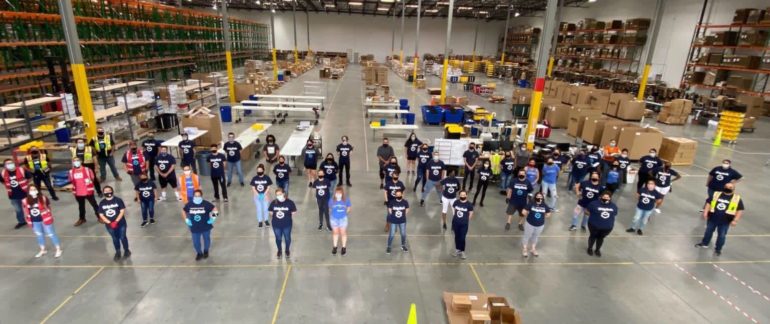After ShipBob decided last July to let staffers work from anywhere, the logistics start-up had its landlord erect a wall in the middle of its Chicago headquarters so half the space could be rented out to another company.
On March 1, the office reopened at reduced capacity for socially distanced meetings.
But while it’s using less office space, ShipBob’s real estate needs have been expanding at a breakneck pace. The company, which provides fulfillment services to online retailers, has more than doubled its warehouse count since mid-2020 to 24 locations today, including four outside the U.S., with plans to reach 35 by the end of 2021.
The seven-year-old company is a microcosm of the U.S. commercial real estate market. While office vacancies have soared as employers prepare for a post-Covid future of distributed work, the industrial market is hotter than ever because of a pandemic-fueled surge in e-commerce and increased consumer demand to get more products at Amazon-like speeds.
Vacancy rates in industrial buildings are near a record low and new warehouses can’t get built quickly enough to meet the needs of clothing makers, furniture sellers and home appliance manufacturers. Real estate firm CBRE said in its first-quarter report on the industrial and logistics market that almost 100 million square feet of space was absorbed in the period, the third-highest amount ever, and that a record 376 million square feet is under construction.
Rents rose 7.1% in the quarter from the same period a year earlier to an all-time high of $8.44 per square foot, CBRE said. The firm wrote in a follow-up report last month that prices in coastal markets near population centers and inland port hubs are soaring by double-digit percentages. In Northern New Jersey, average base rent for industrial properties jumped 33% in May from a year earlier, and California’s Inland Empire saw an increase of 24%, followed by Philadelphia at 20%.
“The need to have facilities in these markets, coupled with record low vacancy rates, has often led to bidding wars among occupiers that are driving up rental rates,” CBRE said.
Skyrocketing prices
The wheels were well in motion before Covid-19 hit the U.S. in early 2020. Amazon was already turning next-day delivery into the default option for Prime members, and big box stores like Best Buy and Walmart were racing to add fulfillment space to try and keep pace.
The pandemic accelerated everything. Consumers were stuck at home and ordering more stuff, while physical stores had to go digital to stay afloat.
Grocery delivery added to the market tightness, as Instacart and Postmates were suddenly inundated with orders from customers who didn’t want to enter a Costco, Albertsons or Kroger store. Instacart is now planning a network of fulfillment centers loaded up with cereal-picking robots, according to Bloomberg, and Target has bolstered same-day fulfillment through so-called sortation centers.
In addition to the rapid change in consumer behavior, the pandemic also exposed the fragility of the global supply chain. With facilities in China and elsewhere shuttered, stores experienced dramatic shortages of apparel, car parts and packaging materials.
Retailers responded by securing more storage space to mitigate the impact of future shocks, said James Koman, CEO of ElmTree Funds, a private equity firm focused on commercial real estate.
“The reshoring of manufacturing is gaining momentum,” Koman said. Companies are “bringing more products onshore and need to have room for their products so we don’t fall into another situation like we’re in right now.”
All of those factors are contributing to skyrocketing prices, he said. Additionally, construction costs are higher because of inflation and supply constraints, and companies are building more sophisticated facilities, filled with robots.
“You have these automatic forklifts, conveyor belts, and automated storage retrieval systems,” Koman said. “All this is where the world is going.”
Betting on a long-term need for fulfillment and logistics facilities, ElmTree has acquired about $2 billion worth of industrial space over the past seven months, outpacing prior years, Koman said. He estimates the U.S. will need an additional 135-150 million square feet annually to support e-commerce growth.
For ShipBob, the e-commerce boom has played right into its business model. But competition for space is simultaneously forcing the company to reckon with higher costs.
ShipBob works with brands like perfume company Dossier, powdered energy drink maker Juspy and Tom Brady’s sports and fitness brand TB12, providing a wide network of fulfillment centers for fast and reliable shipping and software to manage deliveries and inventory.
Unlike the retail giants, ShipBob doesn’t go after large football field-sized fulfillment centers, and only has leases at a few of its facilities. Rather, it looks for warehouses that are typically family-owned with 75,000-100,000 square feet and some unused capacity. It then outfits them with ShipBob technology and pays based on order volume and the amount of space it uses.
While ShipBob isn’t signing leases, it is competing for space in warehouses that are now sitting on much more valuable property than they were a year ago. ShipBob CEO Dhruv Saxena said that his company has to be in areas like Southern California and Louisville, Kentucky, a major transportation and logistics hub, despite the rapid increase in prices.
“We have to find ways of placing inventory closer to the end customer even if it comes at a lower margin for us,” Saxena said in an interview late last month after his company raised $200 million at a valuation topping $1 billion.
ShipBob competes directly with a number of fulfillment outsourcing start-ups, including ShipMonk, Deliverr and Shippo. Those four companies have raised almost $900 million combined in the past year.
Not just Amazon
Saxena said a major reason smaller retailers turn to ShipBob is to avoid the costs and hassle of finding fulfillment space and hiring the requisite workers. He likened it to companies outsourcing their computing and data storage needs to Amazon Web Services and paying for how much capacity they use rather than leasing their own data centers.
“The same math applies,” Saxena said. “I can open a warehouse, hire people and rig the software or I can convert those fixed costs into variable costs where I pay on a transaction basis.”
Nate Faust is in the very early stages of building Olive, an e-commerce start-up that’s working with brands to offer more sustainable packaging and delivery options by using recycled boxing materials and bundling items.
Olive opened its first two 30,000 square foot warehouses last year, one in New Jersey and the other in Southern California. Faust, who previously co-founded Jet.com and then worked at Walmart after the acquisition, said if he were entering those leases today, they’d easily be 10% to 15% higher.
Olive isn’t actively in the market for more fulfillment centers and doesn’t face a lease renewal until February, but Faust said start-ups have to be opportunistic. He’s working with real estate firm JLL, which he said is constantly on the prowl for attractive space.
“We have them looking all the time because industrial space is so tight right now,” Faust said. “If we find something perfect for what we’re looking for, it’s not unreasonable to have overlapping leases.”
Vik Chawla, a partner at venture firm Fifth Wall, which invests in property technologies, said the challenges in the real estate market are driving more emerging brands and sellers to the outsourcing model.
“It’s very difficult as a single e-commerce business to try to secure attractive space and run your business,” Chawla said. “The line of people trying to get into industrial buildings is out the door.”
Many tenants occupying that line are traditional big third-party logistics providers (3PLs), like C.H. Robinson and XPO Logistics as well as UPS and FedEx. At the top end of the market, Amazon, Walmart and Target are mopping up space to speed distribution and, in Amazon’s case, to manage fulfillment for its massive marketplace of third-party sellers.
Prologis, the largest U.S. owner of industrial real estate, said in a May report that utilization rates, which indicate how much space is being used, reached close to 85%. Vacancy rates are at 4.7%, close to a record low, the company said.
Amazon is the real estate firm’s biggest customer, occupying 22 million square feet, followed by Home Depot at 9 million and then FedEx and UPS, according to Prologis’ latest annual report. Walmart is seventh.
In April, an analyst on Prologis’ earnings call asked what types of clients were most actively pursuing leases.
“E-commerce is a big component of it, but it’s certainly not all about Amazon,” Michael Curless, Prologis’ chief customer officer, said in response. “Certainly, they’re the most active customer. But we’re seeing a lot of activity from the Targets, the Walmarts, Home Depots, and lots of evidence of the Chinese players making their way to the U.S. and Europe as well.”
WATCH: EY on how Covid has boosted digitalization in the retail industry



